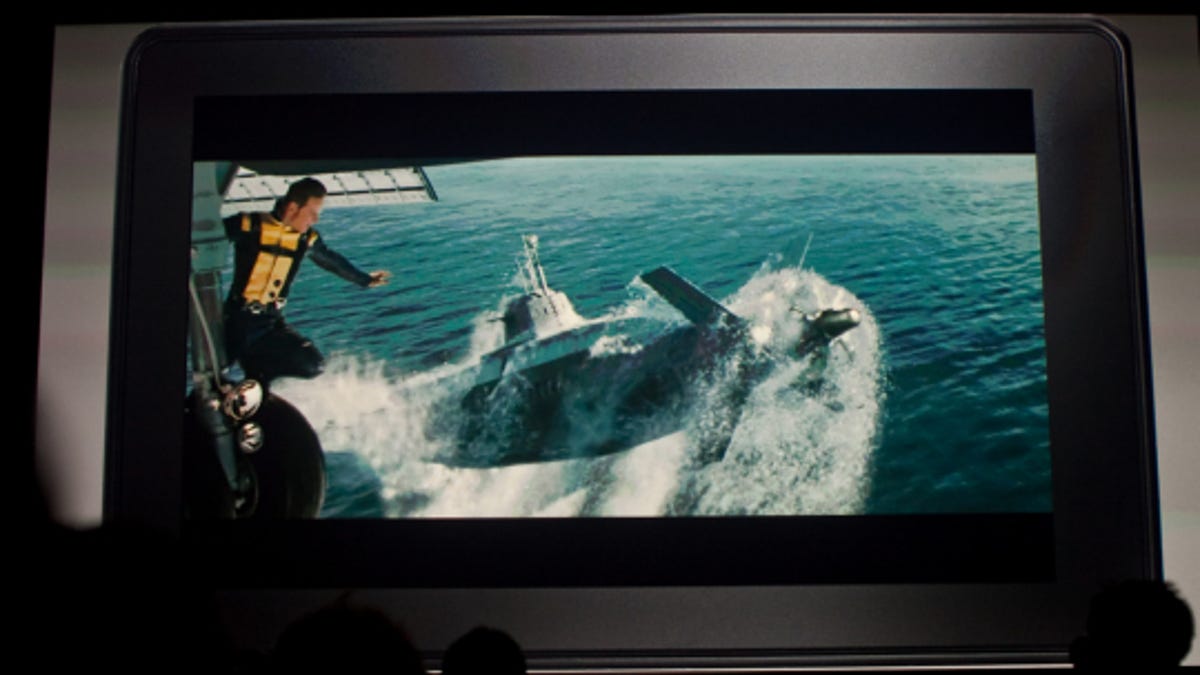Amazon fires on Netflix with new Kindle tablet
Amazon's new Fire tablet, which comes bundled with a one-month free subscription to Amazon Prime, is a significant offer that will put some heat on Netflix.

Amazon CEO Jeff Bezos served notice today that his company is very much a Netflix competitor.
Some analysts predicted that Amazon would not make a serious effort in online video distribution. But at a press event in New York this morning, Amazon kicked Netflix where it hurts the most right now: price and value. The Web's largest retailer announced a series of new electronic readers as well as a tablet computer called the Kindle Fire (See CNET's first look at the device). Amazon wrapped the tablet into a hard-to-beat offer for many movie fans.
Not only is the Fire a lot cheaper than the iPad but Amazon is offering to bundle it with a free one-month subscription to Amazon Prime. In addition to free two-day shipping on any purchase from the store, Amazon Prime customers receive "instant commercial-free streaming of over 11,000 movies and TV shows at no additional cost." After the free month is over, Fire owners can sign up for Prime which costs $79 annually.
Let's spell that out: Amazon streaming movies cost $79. Netflix's streaming movies cost $96. And Netflix can't offer the free shipping on a seemingly infinite amount of consumer goods.
This leads us to the question many have been asking for months now: What's happened to Netflix? One day they're out in front of the hot segment, delivering movies and TV shows over the Web, and competitors aren't even in the rear-view mirror. Then, suddenly the company's stock is plunging, subscribers are canceling in a huff, and rivals begin piling on.
Related stories:
• Amazon unveils Kindle Fire tablet for $199
• Amazon lights a Fire with its Kindle tablet (photos)
• Netflix DVD spinoff adds to woes (roundup)
The trouble started in July when Netflix managers announced they would do away with a popular subscription plan, thus raising prices for some customers. As a result, managers acknowledged that the number of subscriber cancellations was larger than they expected and would mean fewer customers in the third quarter.
More subscribers were turned off when Netflix announced two weeks ago that it's splitting the company into two services.
You want DVDs? You have to go to a new Web site called Qwikster, Netflix told customers. While this is all very confusing to consumers, competitors view Netflix's seemingly erratic actions as a distress call. Not surprisingly, they're not sending "Get Well Soon" cards. They smell blood. They're lying in wait, looking to snatch market share from Netflix.
In terms of video customers, Amazon won't close the gap on Netflix for some time, says Dan Rayburn, principal analyst at research firm Frost & Sullivan. Netflix offers 20,000 movies compared to Amazon's 11,000. He says too many people still don't know what Amazon Prime offers. But he says the device is the game changer and Netflix had better watch out.
Amazon's streaming service is going to piggyback on its Fire device that Rayburn predicts will be white hot.
Because of Fire's low price ($199) "Amazon is going to jump-start the (tablet market) the way Netflix did (for online video) a few years ago," Rayburn said. "They're going to put a tablet into the hands of the mass market, where the iPad right now is not affordable enough."
And Rayburn predicts Amazon will do a better job in the future of marketing Prime. He also doesn't expect Netflix to hold on to its lead in the amount of streaming content for very long. He said Amazon is adding movies and TV shows at a much faster rate than Netflix did at the same point in its history.
"In January of 2008, Netflix confirmed it had about 12,000 titles available for streaming," Rayburn wrote last October. "In September of 2009, ads on their website put that number at 17,000. Today, it appears that Netflix has about 20,000 titles for streaming, although Netflix won't confirm that number for me. If that number is accurate, it means that Netflix has only added about 4,000 movies a year for the past two years."
Amazon's streaming service boasted 5,000 at launch in February. The company says it has 11,000 now, or an increase of 6,000 titles in six months. And don't forget, Amazon has the suppliers on its side. The major Hollywood studios don't want a single company dominating any distribution category and Netflix for a while appeared to be on its way to doing that. Studios and TV networks want competition among distributors.
They also want partners that will try to sell and rent movies on a per-title basis, which Amazon does, instead of an all-you-can-eat model, which Netflix does. There's more money for Hollywood in an a la carte service.
Separate from the 11,000 streaming titles offered to Prime members, Amazon offers 100,000 movies and TV shows for rent or to own on a per-title basis. These are available for streaming as well as download.
Consumers have overwhelmingly shown that they prefer Netflix's model. What remains to be seen is whether that will hold true if competitors, such as Amazon, offer a better selection of titles.

